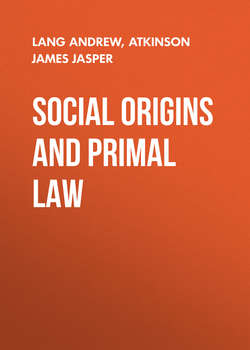Читать книгу Social Origins and Primal Law - Lang Andrew - Страница 24
CHAPTER III
TOTEMS WITHIN THE PHRATRIES
THE IDEAS OF MR. FRAZER HIS EARLIER THEORY
ОглавлениеIt cannot be concealed that my conjecture is opposed to the mass of learned opinion, which represents the primary 'phratries' as the first exogamous bodies, and the totems in each as later subdivisions of the phratries. The writers who, like Mr. Fison, recognise that the primary subdivisions are themselves, in origin, totem divisions, do not (as I understand) regard these very ancient totem groups as already exogamous, before the institution of 'phratries.'
Again, turning from Australia to North America, we find Mr. Frazer, at least in one passage, on the side of the view generally held. Of the 'phratry,' in America, he says, 'the evidence goes to show that in many cases it was originally a totem clan which has undergone subdivision.'91 Many examples are then given of the North American 'phratries,' which include totem groups within them. 'The Choctaws were divided into two phratries, each of which included four clans' (totem kins); 'marriage was prohibited between members of the same phratry, but members of either phratry could marry into any clan of the other.' Among the Senecas, one phratry included the Bear, Wolf, Beaver, and Turtle totems: the other held the Deer, Snipe, Heron, and Hawk totems; just as in Australia. Among the Thlinkets and Mohegans, 'each phratry bears a name which is also the name of one of the clans' (totems) 'included in it;' Mr. Frazer adds, 'it seems probable that the names of the Raven and Wolf were the two original clans of the Thlinkets, which afterwards by subdivision became phratries.'92 This is precisely as if we were to argue that Matthurie and Kirarawa were the 'two original clans' of the Urabunna, 'which afterwards by subdivision' (into totem groups) 'became phratries,' or 'primary exogamous divisions.'
The objections to this theory, as advocated by Australian inquirers, apply to the American cases as interpreted here by Mr. Frazer. In the first place, how are we to conceive of a large tribe, like the Thlinkets, as originally containing only two totems, Raven and Wolf?93 If we do take this view, we seem almost driven to suppose that, in exceedingly early times, the Thlinkets deliberately bisected themselves, for some reason, called one moiety Ravens, the other moiety Wolves, and then made the divisions exogamous. Or, perhaps, having two totems and only two, Raven and Wolf, they deliberately decided that members of neither group should marry within itself; but should always take wives from the other group. Later, the two tribes, Raven and Wolf, again deliberately subdivided themselves, or perhaps, as in Dr. Durkheim's view, Wolf threw off colonies which became five totem kins, and Raven threw off colonies which became five other totem kins.
Is it not more readily credible that, over a large extent of Thlinket country, many small local groups came, by an unconscious process (see 'The Origin of Totemism'), to bear each a separate totem name? The two most important local groups, Raven and Wolf, would inevitably each contain, by the working of exogamy and female kin, members of all the other totems which would array themselves, five in each chief group, Raven and Wolf, as I have conjectured in speaking of the Australian cases.94
Again, I cannot believe that a tribe like the Thlinkets originally had but two totems, not yet exogamous, then made them exogamous, and then cut them up, or let them split off, into many exogamous totem groups. No motive is obvious: the people, by the theory, being exogamous already.
91
Totemism, p. 60 (1889).
92
Totemism, p. 62.
93
The people of New Britain group of islands are divided into two exogamous sets. The totems of these classes are two insects, but I incline to suppose that there are, or may have been, totem kins included within these totemic classes. Our informant, the Rev. B. Danks, regrets that he did not pay more attention to these matters. J. A. I. xviii. 281-294.
94
On the other hand, among the Mohegans, I can admit that Little Turtle, Mud Turtle, and Great Turtle may be deliberate subdivisions of the Turtle totem, now a phratry, but even this need not necessarily be the case; the different species of turtles being quite capable of giving names to different totems. I would not deny the possibility of the occasional segmentation of a totem group – far from it – but I doubt whether great tribes originally (and, as it seems, deliberately) first bisected themselves, and then cut up the two main divisions.
